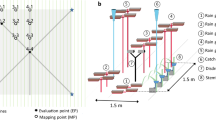Summary
The line-source sprinkler system provides a water application pattern which is uniform along the length of the plot and continuously variable across the plot. A double line-source system is described which makes it possible to determine simultaneously the response functions for two factors — salinity and water — and their interaction, on a relatively small area. It is based on two parallel sprinkler lines with overlapping wetting, supplied with water of different quality. The lines are fitted with groups of sprinklers with a range of nozzle sizes to produce different rates of water application. This modified line-source technique has the following advantages: (i) it produces a wide range of water application amounts in combination with a large gradient in water salinity; (ii) different rates of water application are obtained between the two lines within each salinity level; and (iii) on the side of the lines where no overlapping occurs, the use of different rates results in the application of the same amount of water at different distances from the line-source. This is in contrast to the common line-source arrangement, in which the amount of water falling at a given distance from the line is always the same. A study using the double line-source system was carried out to determine the interactive effects of water and salinity on forage corn.
Similar content being viewed by others
References
Hanks RJ, Ashcroft GL, Rasmussen VP, Wilson GD (1978) Corn production as influenced by irrigation and salinity: Utah Studies. Irrig Sci 1:47
Hanks RJ, Keller J, Rasmussen VP, Wilson GD (1976) Line source sprinkler for continuous variable irrigation-crop production studies. Soil Sci Soc Am J 40:426
Hanks RJ, Sisson DV, Hurst RL, Hubbard KG (1980) Statistical analysis of results from irrigation experiments using the line-source sprinkler system. Soil Sci Soc Am J 44:886
Lauer DA (1983) Line-source sprinkler systems for experimentation with sprinkler-applied nitrogen fertilizers. Soil Sci Soc Am J 47:124
Maas EV (1985) Crop tolerance to saline sprinkling water. Pl Soil 89:273
Stark JC, Jarrell WM, Letey J (1982) A modified line source sprinkler technique for continuous-variable leaching studies. Soil Sci Soc Am J 46:441
Stewart JI, Danielson RE, Hanks RJ, Jackson EB, Hagan RM, Pruitt WO, Franklin WT, Riley JP (1977) Optimizing crop production through control of water salinity levels in the soil. Utah Water Research Lab. PR 151-1, Logan, Utah
Stewart JI, Hagan RM, Pruitt WO (1976) Salinity effects on corn yield, evapotranspiration and leaching fraction. Int Salinity Conf Proc, Lubbock, Texas: 316
de Wit CT (1958) Transpiration and crop yields. Inst Biol Chem Res, Field Crops Herb Versl Landbouwk Onderz 64.6, Wageningen
Author information
Authors and Affiliations
Additional information
Contribution from the Agricultural Research Organization, The Volcani Center, Bet Dagan, Israel, No. 2831-E, 1989 series
Rights and permissions
About this article
Cite this article
Frenkel, H., Mantell, A., Vinten, A. et al. Double line-source sprinkler system for determining the separate and interactive effects of water and salinity on forage corn. Irrig Sci 11, 227–231 (1990). https://doi.org/10.1007/BF00190537
Received:
Issue Date:
DOI: https://doi.org/10.1007/BF00190537




